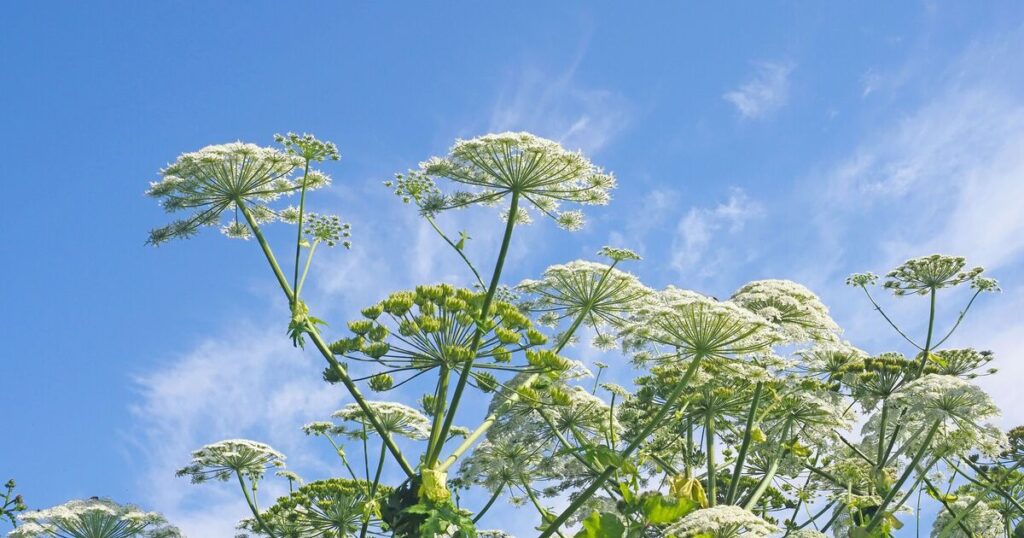
Weed experts are sounding the alarm over a common plant that can inflict severe burns, which may recur for years and even cause blindness. This highly invasive species is particularly dangerous due to its sap, which induces photosensitivity, posing a significant threat to both humans and animals.
Jennifer Holmes of Environment Controls has issued a stark warning about Giant Hogweed, advising extreme caution around this plant commonly found by river paths and in woodlands.
She said: “This dramatic looking plant, found along many a river path, or woodland walk, must be treated with extreme caution. Its toxic sap contains furocoumarin, which makes skin extremely sensitive to sunlight and is a danger to humans and pets. Its distinctive flower heads emerge in June — and can be easily mistaken for other plants such as Cow parsley (non-toxic), Hemlock or Hemlock water dropwort (both highly toxic).”
She further cautioned: “If you touch Giant Hogweed you may not notice anything immediately as the effects may take up to 24 hours to emerge, but soon large blisters will form on skin and will recur when exposed to sunlight. As well as its harmful properties, as it colonises river banks this can make it difficult to eradicate – do not try to remove it yourself, always consult an expert.”
Giant Hogweed, also known as heracleum mantegazzianum, is an invasive, non-native plant species listed on The Invasive Alien Species (Enforcement and Permitting) Order 2019.
Planting this species or allowing it to spread into the wild is an offence, as it aggressively invades natural habitats. Landowners are legally responsible for controlling its growth, and failure to do so — especially if it spreads onto neighbouring properties — can result in fines or other legal consequences.
Daniel Docking from Property Care Association (PCA) also emphasised the importance of public knowledge on the matter: “It is important to make the public aware of the presence of giant hogweed, and the risks associated with exposure to it,” reports Manchester Evening News.
He continued to highlight the growing concern: “This is a highly invasive weed that grows vigorously and its distribution and frequency is increasing over time. Every year there are reports of injuries affecting people who have come into contact with the plant, as it produces a skin reaction that is antagonised by exposure to sunlight.”
Painful Recurring Blisters and Burns
These aren’t your average burns; skin affected by Giant Hogweed may develop blisters repeatedly upon sun exposure, potentially for years after the initial encounter, reports Wales Online.
Blindness and Eye Damage
Exposure to the sap, especially in the eyes, can lead to intense irritation, blurred or lost vision, and, in rare but serious cases, permanent blindness. This makes it particularly dangerous for inquisitive children and pets who may unknowingly come into contact with the common plant.
Deferred Reaction
Those exposed to the dangerous plant may not show symptoms for up to two days, invariably leading to unsuspecting individuals spending even more time in the sun, thus exacerbating the damage.
How to spot Giant Hogweed?
The PCA has issued guidance to help people spot the dangerous giant hogweed, which can often be mistaken for Britain’s native Hogweed, Cow Parsley or Hemlock plants, though these are significantly smaller and have leaves with a smoother edge.
The association strongly advises against getting too close to the plant when trying to identify it.
Key characteristics of giant hogweed
Height: The Giant Hogweed is an exceptionally tall biennial or perennial herbaceous plant, capable of growing over 10 feet.
Flowers: It boasts large, white, umbrella-shaped flower heads (up to 50cm wide) that look like an oversized Cow parsley.
Stem: The stems are thick, hollow, and ridged, coloured green with distinctive purple blotches and stiff, white hairs.
Leaves: The leaves are large, deeply lobed, and sharply toothed, often reaching over a metre in width.
What should you do if you have a reaction to Giant Hogweed?
Should you or your pet come into contact with the sap of Giant Hogweed, it’s imperative to rinse the affected area thoroughly and immediately with soap and cold water. Be sure to keep the exposed skin out of direct sunlight for a minimum of 48 hours.
If blisters develop, or if the sap gets into the eyes, seek urgent medical care.
Due to the persistence of the Giant Hogweed’s seeds and the danger of its toxic sap, professional removal is necessary.
 Latest World Breaking News Online News Portal
Latest World Breaking News Online News Portal






